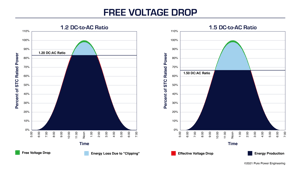Well-executed utility-scale solar projects follow a specific pattern, allowing for completion on time and without additional cost. Arguably one of the most critical factors in the development is managing the intersection of electrical, civil, and...
Continue ReadingCategory Archives: utility-scale-solar
Latest Discussions
When designing utility-scale solar energy projects, optimizing central inverters is a crucial aspect that project developers, EPCs, and stakeholders often overlook. The strategic placement and design of central inverters plays a significant role in...
Continue Reading →
Free Voltage Drop
This is a follow up to the article Design Recommendations for 1500V String inverters, where we only briefly mentioned "Free Voltage Drop" and wanted to dive in a little deeper here.
When we value engineer a large solar project, we can take advantage...
Continue Reading →At Pure Power Engineering, our engineers work closely with project originators, developers and EPC firms to reduce the upfront capital costs of construction without sacrificing long-term operating costs. Given the dynamic nature of solar...
Continue Reading →What is a "Neutral" conductor?
To an Engineer: A "neutral" is a current-carrying conductor that carries the unbalanced current in 3 phase systems, and is intentionally connected to the ground. In North America, the neutral is color-coded white or...
Continue Reading →With 21 engineers between our NJ, CO, and CA offices, we have unmatched bandwidth to design your solar & energy storage projects fast. What does that mean for your project? Quick turnaround time from quality engineers means you can complete your...
Continue Reading →Our first article 2014 NEC 690.12 Rapid Shutdown for String Inverters on Flat Roofs we explained the basics of implementing a rapid shutdown system using string inverters on a roof. In that article, we gave a simple example of a single array.
Continue Reading →The 2014 National Electric Code added a new section of code 690.12 requiring "Rapid Shutdown of PV Systems on Buildings". Below is the first of 1 of 2 articles we put together to help you understand this code (here is the other: 2014 Rapid Shutdown...
Continue Reading →Here is something that’s crazy, and yet we completely understand why they did it. Some evil genius put duct tape around the vents of a NEMA 3R transformer. If this transformer is heavily loaded it runs the risk of overheating, but at least snow cant...
Continue Reading →Thermal (IR) cameras are a great tool for preventative maintenance and inspection of your PV system. With a little thermography “know-how” and some image focusing, problems can be discovered quickly before they create a fault or safety hazard in the...
Continue Reading →On this system, the installer stacked ballast so high that it shades the modules at noon of each day. Why would anyone use a hollow block for ballast?
Continue Reading →This photo is an excellent example of an inverter installation on the roof. Keeping the inverters next to the array allows the unfused string wires to be kept at a minimum length, increasing safety. Notice how the inverters are tilted to the north...
Continue Reading →We were called out to investigate a performance issue at a site, and were shocked to see this wire management. We suspect the AHJ made this contractor install physical protection after the strings were installed, which is why the contractor cut the...
Continue Reading →Just when I thought I have seen it all... Notice the mid-clamp that was never attached because the module was raised off the rail. Scary!
Continue Reading →I appreciate Shoal's new arc fault technology as shown in this advertisement, however I was shocked to see the photo of a man standing on PV modules.
Continue Reading →In a recent project we were able to value engineer a DC combiner feeder by running an overhead line rather than trenching an underground duct bank. The feeder would have been a 175 feet underground duct bank routed across a high traffic driveway...
Continue Reading →In this installation, an AC panel board was located at ground level which combined the AC circuits from string inverters on the roof. We wanted to avoid entering the top of the enclosure with conduits, so a trough was used so that the feeders could...
Continue Reading →During O&M we often find combiner boxes and disconnect switches with water inside them, despite the box being NEMA 4 and fully gasketed, no top or side penetrations, and weather tight connectors properly installed.
Continue Reading →Here is a video I found on the internet, produced by American Apparel. I figured I would share it as an example how NOT to clean PV panels.
Continue Reading →Many roofs are designed to support thousands of pounds of HVAC units and large air handlers, so the additional weight of an inverter is feasible in many cases.
Continue Reading →Be careful with Aluminum Conductors
The cost savings of Aluminum conductors is too good to ignore. Both the engineer and the electrician must respect the differences between copper and the less forgiving aluminum. However, if designed and installed...
Continue Reading →.png)
%20(2).png?width=300&name=Utility-Scale%20Solar%20Coordination%20Article%20(5.25)%20(2).png)



















